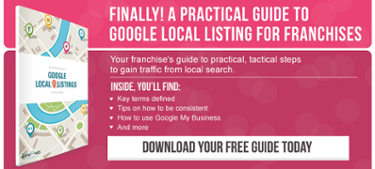Stop Going Bald Over Google Local
Author’s note: This is a joint post written alongside Oneupweb’s Krista Olson. She rocks.
It’s been a long time coming, but Google has re-invested in its local product, now named Google My Business.
For years, business owners, search marketers, and social media consultants have bemoaned the mess that is Google for local businesses. Google local has gone through a number of names over the years, including Google Places and Google+ Local; it even remained somewhat unnamed since Google’s local products didn’t receive a lot of corporate support. And this lack of support was keenly felt by franchise businesses, SMBs, multi-unit corporations, and service-area businesses alike.
For many, gaining a local presence in Google led to hair-pulling moments that left businesses desperate to “do what it takes” to get listed.
But there’s hope now (and reasons why it’s time to clean up your local account.)
Welcome to Google My Business.
For our part, we are cautiously optimistic (cautionary notes later) about Google’s renewed commitment to local. Google My Business does more completely and seamlessly merge Places and Plus by offering business owners a single interface through which to engage customers socially, organize and submit important information like store hours and driving directions, and show up on Google properties like Maps and the SERP. Furthermore, Google My Business offers quick, easy access to other products that might prove useful, like AdWords Express and Analytics.
To break it down even further, here are some of the nifty things you can do with Google My Business:
Sharing Is Simple
When you want to share something on Google+, simply choose the button you want (event, video, text, photo) and Google takes you through the process, using easy-to-understand instructions and forms. If you want to share a video, for instance, you have several easy options: 1) you can search YouTube without leaving your Google My Business page, 2) you can copy and paste a URL from a different tab, or 3) you can upload a clip from your computer by simply dragging it into a box. You can even click “Record video” and Google will autodetect your camera.
Reputation Management, Refined.
Google My Business displays reviews from customers right in your dashboard—and not just those from Google users. It brings in reviews from Yellowpages, Citysearch, Yahoo, and elsewhere. You can even view breakdowns of these reviews by where they came from and the number of stars. More importantly, Google My Business enables you to respond to those reviews, so you can better manage your digital image.
Virtual Tours!
We personally really like virtual tours. Whether we’re looking at real estate or local businesses, they strike our fancy. We’d watch a virtual tour of a single padded cell, and we’d probably watch it several times. Google My Business offers step-by-step instructions for adding a virtual tour, which has been shown to increase conversion rates.
And Now, for the Caution
There are still some things that are rough around the edges, though. The new Insights section in Google My Business, for instance—though it offers some actionable data on your core demographic and what kinds of content they prefer—records views of your business page, but it doesn’t take into account how many of those views came from, say, the digital marketing agency managing your account. One of our clients saw a huge spike in views to their business page on the day several of us just happened to be poking around in there. As with Analytics, we need an option to exclude IP addresses.
Another shortcoming with Google My Business is the Analytics linkup. It’s definitely convenient to be able to click right through to your data, but how that’s currently happening isn’t quite clear. In managing our client’s Google Analytics account and now-updated Google My Business page, we gave Google absolutely no information about which Analytics view to use. Yet somehow, it picked one, and it picked the wrong one. (We did some cursory research on how to edit this and came up with nary a solution.)
Best Practices
With a number of new changes, there are also a set of best practices for marketers to remember:
Assign Ownership
A major issue with the former Google local is that changes could easily be overwritten by other owners or map users. The former owner policy led to many spammy listings or worse yet, competitors submitting requests to Google that competing businesses were closed.
Now, there can only be one owner per My Business account. The owner can assign multiple managers who are able to make changes, but are unable to transfer ownership or make significant changes.
In this owner-manager scenario, you, the business owner, want to retain control of the account, and give your agency, marketing partners, etc. manager access.
Keep Google+ Updated
In the past, you had a website, and you knew you were supposed to be active on Google+. You also knew it was important for customers to find your location, the right phone number, hours, etc., so you probably had a Google local account too. While the long-held intention was to have these two merged, this didn’t happen for many businesses, largely due to the lack of infrastructure and support from Google HQ. With these disparate properties, marketers had a lot of accounts to keep track of and maintain.
Google My Business officially merges your Google local account with the Google+ page you created for your business, so there isn’t any reason to maintain multiple accounts for your different locations. This merger makes it easier for businesses to be found in Google Maps, Google+ and Google search results.
Since you should have fewer accounts to manage, keep Google My Business up to date and post regularly through your My Business dashboard to Google+. If Google suspects that an account is inactive, it may de-verify it.
As with Any Profile, Choose Photos Wisely
With this merger, it’s possible that your business photos were dropped. Treat this as an opportunity to ensure your photos show what your business really looks like from the outside and inside, are customer-friendly and feature your business in the best light. Photos submitted directly from the owner do better than other photos submitted about the business from other users. Here are some technical guidelines:
• Photos must be in one of these formats: JPG, GIF, PNG, TIFF, BMP.
• Each photo must be smaller than 1MB.
• Each photo must be bigger than 256 x 256 pixels, but smaller than 1024 x 1024 pixels.
We also recommend that you select landscape photos over portrait since they look a little better in Google+.
Existing Bulk Listings, Sit Tight
If you have multiple locations (more than 10) and haven’t used Google local before, then you can go through the normal bulk feed verification process. If you have multiple locations and have used/are using Google local, then sit tight, because Google My Business hasn’t rolled out fully to bulk users yet.
The Takeaway
On the whole, Google My Business is definitely an improvement over previous efforts, and it behooves businesses everywhere to take advantage of the streamlined interface and additional insights that this new product offers. Comments? Questions? Gripes? Feel free to leave your two cents below.
Additional Resources
https://support.google.com/places/answer/142916?hl=en
https://support.google.com/business/answer/3038177?hl=en&ref_topic=4540086

